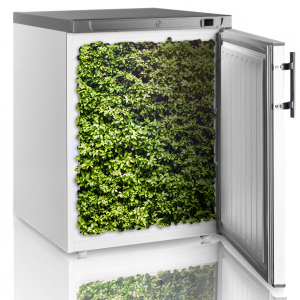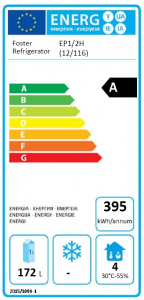
The Future is Green | What's Changed in Commercial Refrigeration? | Minimum Energy Performance Standards (MEPS) | Introducing New Technology | Impact on Price | Foster Refrigerators – Leaders In Green
The worlds focus, now more so than ever, is concentrated on the environment and the impact that our daily lives and actions have on our surroundings. The destruction of the ozone layer that made headlines years ago has morphed into concern over plastic waste littering the land and seas; and rightly so. Climate specialists have issued warnings that time is becoming dangerously limited to avoid the consequences of global warming, stressing increased urgency on the duty of countries to address independent reduction of emissions.
The phrase ‘going green’ is bandied about on a regular basis seemingly by every sector and is undoubtedly a key issue that needs to be responsibly addressed. The commercial foodservice sector is just one industry that is taking a much firmer stance on promoting and observing best practice and lessening environmental impact.
The Future is Green
Customers and businesses are looking to a greener future – and so are manufacturers. Introducing a more transparent approach to the technologies utilized and production processes, manufacturers have never been so exposed (in a good way). Offering genuinely useful advice on the use of equipment and guidance for effective staff training, optimum efficiency is now more achievable than ever. The industry has adopted a refreshingly open and supportive stance, rooted not only in a responsible attitude to the environment but also in the fact that they want customers to experience their brand at its best and get the most from an investment.

What’s changed in Commercial Refrigeration?
Focus on Gases
In 2015, F Gas regulations were introduced with the prime aim to reduce emissions of harmful refrigerants (or F gases). More and more refrigeration manufacturers are now switching from CFC’s, HCFC’s and HFC’s to natural refrigerants. Hydrocarbons (HC’s for short) such as R600a and R290 are becoming a popular choice with low global warming potential and zero ozone depleting potential.
Read more here about F-Gas Regulations.
Manufacturing Processes
Much greater emphasis is now placed on the green production of refrigeration. Using responsibly sourced and easily recyclable materials has become a prime concern for manufacturers worldwide. Companies are employing ‘green’ processes from the choice of raw materials, design, production and manufacture through to performance, maintenance and recycling.
Green Features
Key areas such as advancements in compressors and other inner workings have greatly contributed to more efficient operation and more effective maintenance; issues that the majority of refrigeration manufacturers continuously strive to improve and develop. It’s not just the base design and major components that have been given a make-over – there’s plenty of other ‘green’ features that are now a standard part of new designs. Look for efficient LED lighting, self-closing doors to minimise the escape of cold air, replaceable door seals to guarantee an effective seal is always maintained and digital controls for ultimate precision over settings.
Did you know? Correct temperature selection is vital to observing ‘green operation’ and energy efficiency. Fluctuating by just 1°C below recommended temperatures could see running costs rise by 2-4%. (Source: Carbon Trust Food Preparation and Catering Report)
Sustainability is Key
Sustainability is a key issue and an area where refrigeration manufacturers are hoping to enable the continued use of essential commercial refrigerators without any detrimental impact on the environment. The primary concerns are to reduce power consumption, minimise environmental impact and lessen emissions.
With improved manufacturing processes and advanced technology comes increased reliability and durability. Extending the lifespan of equipment means that less units are being prematurely sent to the scrap heap (or recycled depending on materials). This provides the opportunity for businesses to make their initial investment back within the equipment’s lifetime; a goal well within reach especially when combined with increased efficiency.
Ready to Help and Advise
Who knows the ins and outs of products better than anyone? … The manufacturers who make them. In order to achieve better, more efficient performance manufacturers now offer a plethora of guidelines, advice and tips to educate businesses on best practice. This includes information on operational settings, recommended cleaning processes, maintenance procedures and daily checks; all areas that can make units much more efficient. Advice on correct positioning is also available underlining the fact that commercial refrigeration should be located in the coolest area with ample airflow around the equipment.

Minimum Energy Performance Standards (MEPS)
In 2016 new legislation from The European Commission was introduced under the heading Minimum Energy Performance Standards (commonly referred to as MEPS) to address and successfully limit maximum energy consumption during operation. This new system initially involved the labelling of all solid door, fan assisted cabinets within the commercial refrigeration sector with other categories such as glass door and display units expected to be added in the future.
With businesses embracing the new legislation, the new green, more efficient attitude of manufacturers was apparent. Creating a level of clarity into the performance and statistics of refrigeration that has never witnessed before, MEPS not only display the advances made by manufacturers to address climate issues but ultimately allow customers to easily compare efficiency levels between equipment and brands.
Introducing New Technology
Ever walked around a supermarket and felt a noticeable drop in temperature down the chilled aisle? That’s cold air (or wasted energy if you will) spewing out of open fronted display refrigerators and away from contents. This escape of air means that more energy is needed to maintain foods at appropriate temperatures – not very efficient.
Taking inspiration from and merging ideas with other areas in the manufacturing and engineering sector, new refrigeration technologies are being developed and enhanced to further reduce energy consumption. Big name supermarkets are now lowering energy use and increasing efficiency by using aerofoils inspired by Formula 1 on display cabinets. Using the scientific theory of aerodynamics, cold air is directed back into open fronted equipment (such as multidecks) rather than escaping as waste energy into aisles. It’s suggested that these new additions could lower energy consumption and reduce emissions by around 15%. Source: aerofoil-energy.co.uk
Impact on Price
While the majority of businesses want to get behind the ‘green’ cause, not everyone is financially able. Green efficiency, at present, often comes with a heftier price tag meaning that for some it’s just not a viable option. Ongoing concerns of commercial kitchens over purchasing costs reinforce the fact that price still remains a major factor when selecting equipment – even if it’s the right choice environmentally.

ECA Scheme
To enable more businesses to be in a position to make the right choice environmentally, services such as the ECA Scheme were introduced. The ECA Scheme is a government initiative to promote the purchase of greener equipment choices, allowing businesses to write off the cost of energy efficient equipment against taxable profits. To take advantage of the scheme, the intended purchase must appear on the Energy Technology List (ETL).
Foster Refrigerator - Leaders in Green
An undisputed leader in the advancement of green equipment is Foster Refrigerators. As the UK’s first refrigeration manufacturer to be awarded an energy efficient ISO 14001 certification, this brand has continued to develop and evolve technologies. Spearheading the market for green technology Foster make advanced efficiency accessible for everyone with the offer of a 12 months interest free credit option.
Customers now expect businesses to be environmentally aware showing responsible attitudes and compliance to green initiatives. Displaying an active stance to ‘going green’ can positively affect and strengthen numerous relationships throughout the supply chain. Suppliers want to work with manufacturers that show dedication to improving the efficiency of equipment, end users (e.g. restaurants) want to invest in green equipment supplied by environmentally responsible manufacturers, and customers (e.g. dining guests) will be encouraged by an end user’s (e.g. restaurants) dedication to helping the planet. A positive, beneficial outcome for all parties involved … including the big winner, the environment.
The evolution of truly green commercial refrigeration may have come on leaps and bounds however there’s still a way to go. While the concept of ‘going green’ at a price all businesses can afford, may seem like a tall order at present, with advancements in processes and technology being made thick and fast, a truly utopian commercial refrigeration market may be on the horizon.

Leave a Comment
Your email address will not be published. Required fields are marked *